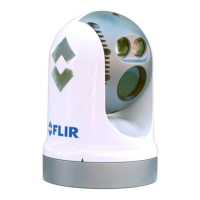432-0012-01-12 Version 110 23
4
IP Interface and PC Operations
The M500 camera and JCU II are network devices that communicate over an Ethernet network
using Internet Protocol (IP). In addition to using the JCU II to control and configure a camera, a
user or installer can also complete similar operations and more advanced configurations using a
Web browser to view the video and control the camera.
Once the camera is connected to a network and powered on, a video management system (VMS)
or a network video recorder (for example, FLIR DNR400 Series) can record video streams and
provide other features such as cloud storage. Refer to the documentation of any VMS or video
recorder for operation and setup details.
The M500 camera and JCU II are shipped with Dynamic Host Configuration Protocol (DHCP)
enabled to assign IP addresses. During installation or at other times the system may have been
set to Static addressing and these addresses may have been changed.
M500 Web Browser Interface
This chapter describes how to use a Web browser to communicate with and configure the M500
cameras and JCU IIs:
• “View Camera and JCU II IP Address” on page 24
• “Camera Web Server Login Accounts” on page 24
• “Log in to the Camera Web Server” on page 24
• “Setup Menu” on page 28
• “Maintenance Menus” on page 33
• “Maintenance->Server->LAN Settings” on page 34
• “Enable ONVIF v2.0 Driver” on page 35
• “Azimuth and Elevation Offsets” on page 36
• “Changing Video Outputs” on page 37
• “Geo-Referencing of the Sensors” on page 39
• “Software Update” on page 40
• “Accessing the JCU II Web Interface” on page 40
Caution: Changes to configuration settings should only be made by someone who has expertise
with M500 cameras and a thorough understanding of how the settings affect the image.
Haphazard changes can lead to image problems including a complete loss of video.

